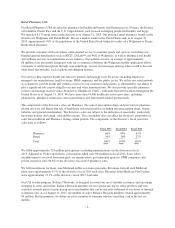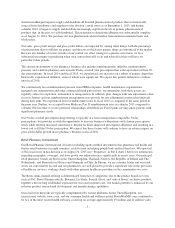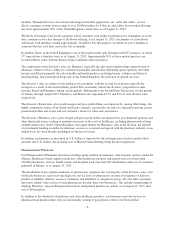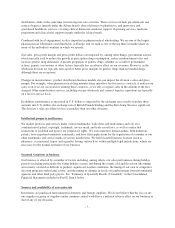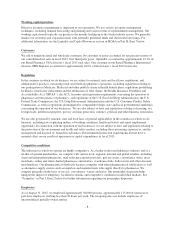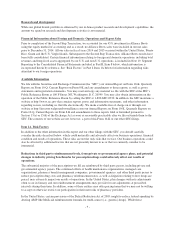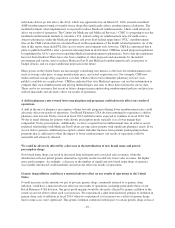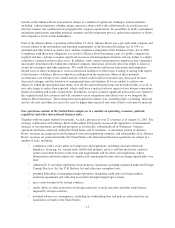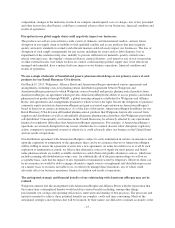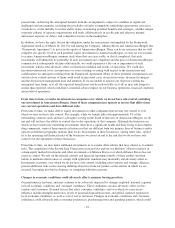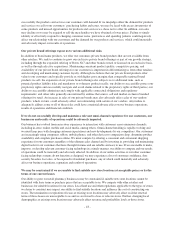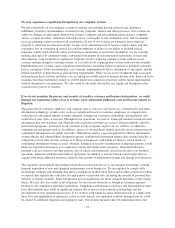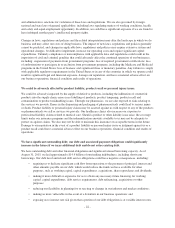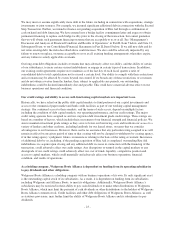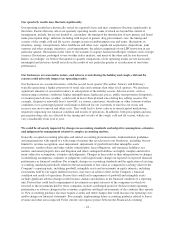Walgreens 2015 Annual Report Download - page 18
Download and view the complete annual report
Please find page 18 of the 2015 Walgreens annual report below. You can navigate through the pages in the report by either clicking on the pages listed below, or by using the keyword search tool below to find specific information within the annual report.• fluctuations in currency exchange rates, including uncertainty regarding the Euro;
• impact of recessions and economic slowdowns in economies outside the United States, including
foreign currency devaluation, higher interest rates, inflation, and increased government regulation or
ownership of traditional private businesses;
• the instability of foreign economies, governments and currencies and unexpected regulatory, economic
or political changes in foreign markets; and
• developing and emerging markets may be especially vulnerable to periods of instability and unexpected
changes, and consumers in those markets may have relatively limited resources to spend on products
and services.
These factors can also adversely affect our payers, vendors and customers in international markets, which in turn
can negatively impact our businesses. We cannot assure you that one or more of these factors will not have a
material adverse effect on our business operations, results of operation or financial condition.
Our significant operations outside of the United States also expose us to currency exchange rate fluctuations and
related risks, including transaction currency exposures relating to the import and export of goods in currencies
other than businesses’ functional currencies as well as currency translation exposures relating to profits and net
assets denominated in currencies other than the U.S. dollar. We present our financial statements in U.S. dollars
and, since the completion of the strategic combination with Alliance Boots in December 2014, have had a
significant proportion of net assets and income in non-U.S. dollar currencies, primarily British Pounds Sterling
and the Euro, as well as a range of emerging market currencies. Our results of operations and capital ratios can
therefore be sensitive to movements in foreign exchange rates. Due to the constantly changing currency
exposures to which we are subject and the volatility of currency exchange rates, we cannot predict the effect of
exchange rate fluctuations upon our future results of operations. In addition, fluctuations in currencies relative to
the U.S. dollar may make it more difficult to perform period-to-period comparisons of our reported results of
operations. A depreciation of non-U.S. dollar currencies relative to the U.S. dollar could have a significant
adverse impact on our results of operations.
We may from time to time, in some instances enter into foreign currency contracts or other derivative
instruments intended to hedge a portion of our foreign currency fluctuation risks, which subjects us to additional
risks such as the risk that counterparties may fail to honor their obligations to us. Additionally, we may (and
currently do) use foreign currency borrowings to hedge some of our foreign currency fluctuation risks. The
periodic use of such hedging activities may not offset any or more than a portion of the adverse financial effects
of unfavorable movements in foreign exchange rates over the limited time the hedges are in place. We cannot
assure you that fluctuations in foreign currency exchange rates, including particularly the strengthening of the
U.S. dollar against major currencies or the currencies of large developing countries, will not materially affect our
consolidated financial results.
Our business results depend on our ability to successfully manage ongoing organizational change and
achieve cost savings initiatives.
In April 2015, our Board of Directors approved a plan to implement the Cost Transformation Program described
in MD&A in Part II, Item 7 below as part of an initiative to reduce costs and increase operating efficiencies.
There can be no assurance that we will realize, in full or in part, the anticipated benefits of this program. Our
financial goals assume a level of productivity improvement, including those reflected in our Cost Transformation
Program and other business optimization initiatives. If we are unable to deliver these expected productivity
improvements, while continuing to invest in business growth, our financial results could be adversely impacted.
Our ability to successfully manage and execute these initiatives and realize expected savings and benefits in the
amounts and at the times anticipated is important to our business success. Any failure to do so, which could
result from our inability to successfully execute plans, changes in global or regional economic conditions,
-14-


